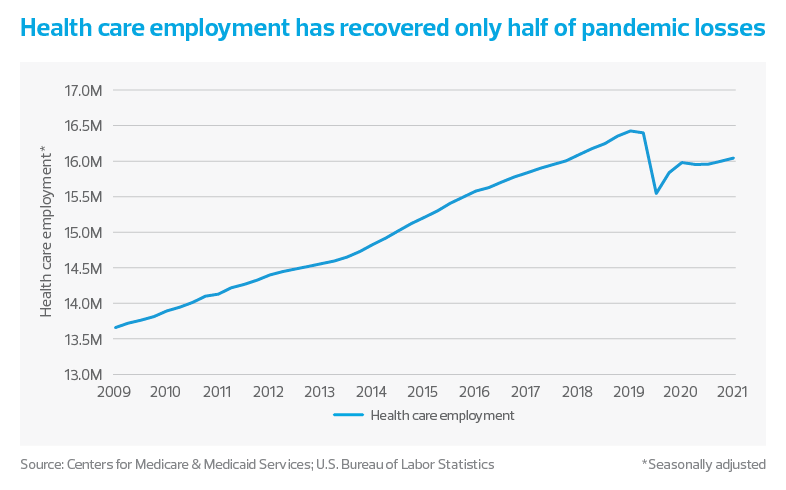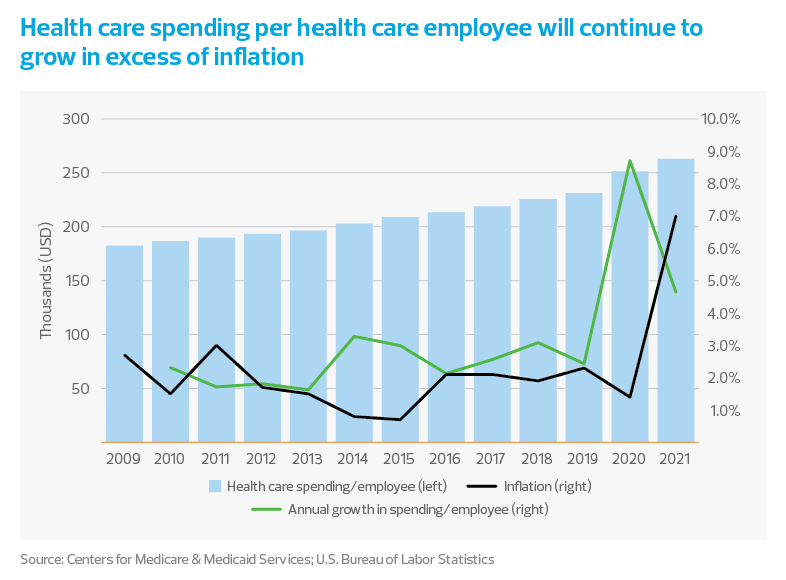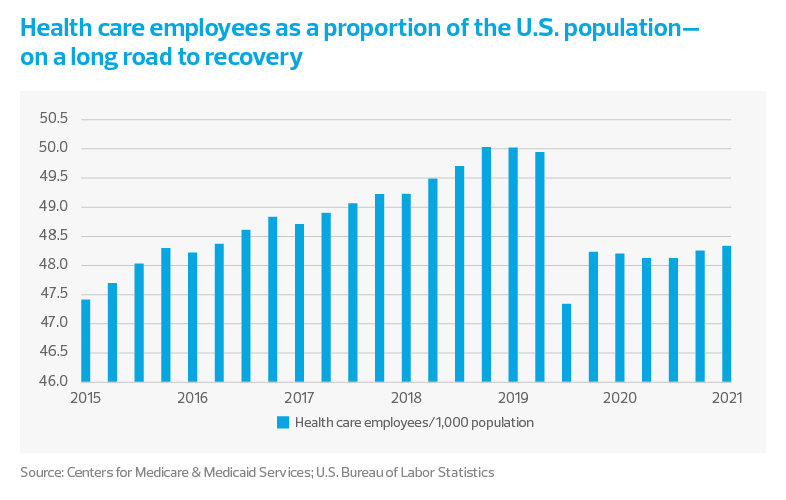The health care ecosystem continues to struggle with a depressed labor supply, a situation unlikely to abate in the near term.
Key takeaways
Technologies like robotic process automation and descriptive analytics will soon become requirements for any organization to be competitive.
Health care organizations will be forced to explore new technology solutions to fill the human labor gap.
The health care ecosystem continues to struggle with a depressed labor supply, a situation unlikely to abate in the near term. From January through June 2020, the number of health care employees decreased by 879,800 to 15.5 million. At the end of 2021, that figure had increased by 498,400—yet the sector remains 381,400 employees short of the pre-pandemic high.
As the nation’s population continues to grow and the demand for services increases, health care organizations will need to attract and retain talent in new and creative ways, and deploy advanced automation and analytic tools, or both, to remain competitive and serve their patient populations.

Even when health care employment returns to pre-pandemic levels, Americans will need more health care services as we deal with COVID-19 in the short term as well as our aging population in both the short and the long term.
One way to measure demand for health care services is to look at total health care spending. At the end of 2021, that spending topped $4.2 trillion dollars, which is 19.7% of U.S. gross domestic product. This represents annual growth of 4.5% since 2011, when the United States spent $2.7 trillion on health care services. The U.S. Centers for Medicare & Medicaid Services (CMS) estimates health care spending will reach $6.2 trillion by the end of 2028. This growth far exceeds historical inflation and projections of future inflation—and signals that health care demand will continue to grow quickly for years to come.
Even prior to the pandemic, health care employment had not kept pace with the increase in spending. Most health care is still delivered by human beings, and we continually ask those who remain employed in health care to do more with less.
At the end of 2021, health care spending per health care employee peaked at $262,872. This figure was certainly affected by increased government spending on care related to COVID-19. However, by the end of 2019, pre-pandemic spending per employee had increased to $231,089, from $182,434 in 2009. This represents an annual increase of 2.4%, which also exceeded inflation over that period, with the exception of 2011.

Part of what is driving increased health care expenditures, and thus increased spending per health care employee, is population growth. According to census bureau estimates, the U.S. population is currently 331.9 million, and will grow to 347.3 million by the end of 2025.
Given this expected population growth, to maintain current staffing levels the health care sector will have to hire 744,690 employees during the next four years, or 186,000 employees per year. To return to pre-pandemic staffing levels, the sector must hire over 1.3 million employees through 2025, or 333,000 employees per year.
Prior to the pandemic, 50 Americans out of every 1,000 were employed in health care. The sector ended 2021 at a ratio of 48.3 health care employees per 1,000 Americans, improving from a five-year low of 47.3 in the second quarter of 2020, but still lagging.

The data is clear: Americans will need more health care services, and there will likely be fewer health care workers to deliver those services in proportion to population or health care spending metrics. This represents a structural shift in the health care ecosystem rather than a transitory labor environment that will eventually revert to the pre-pandemic “normal.”
Health care organizations will be forced to explore new technology solutions to fill the human labor gap. Leading organizations will need to carefully analyze the appropriate mix of digital and human solutions for a given process or function, and work to upskill increasingly scarce health care employees to ensure they are put to their highest and best use.
Once cutting-edge, technologies like robotic process automation and descriptive analytics will soon become requirements for any organization to be competitive not only in serving patients, but in attracting and retaining talent. Leading organizations will deploy the next generation of predictive analytics, artificial intelligence, augmented reality and other technologies to stay ahead of the curve.
Subscribe to Health Care Leader Insights
Actionable insights to help health care industry leaders successfully navigate challenges and take advantage of opportunity.
The Real Economy
Monthly economic report
A monthly economic report for middle market business leaders.
Industry outlooks
Industry-specific quarterly insights for the middle market.

